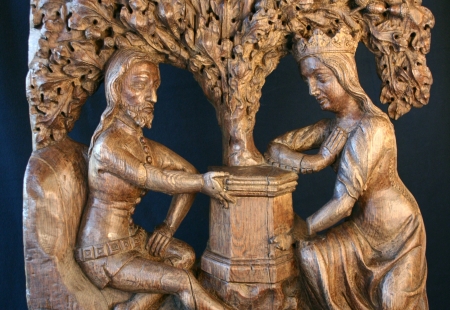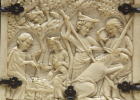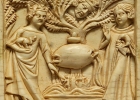Tristan and Isolde
The depiction of the most popular love story of the Middle Ages on the bench end is a clear sign of the fact that the councillors of Tallinn were familiar with courtly culture. The story about the brave knight Tristan and Queen Isolde, based on Celtic mythology, became well known in medieval times through the courtly literature. The courtly romance introduced the glorification of love at a time when marriage was a mere business transaction, which helped strengthen one’s social position and increase wealth – it was also common in Tallinn, where merchants set the foundations of their future career by marrying daughters or widows of councillors. Love was just a dream – sought-after, but unreal. The love story of Tristan and Isolde of course fascinated medieval people because lovers ignored all social rules in the name of love, deceiving their kings, spouses, and God. Earthly love brought pain and suffering to lovers and ended in tragedy, which was typical of the era, yet lovers reunited in Heaven, in front of God.
The Tryst of Tristan and Isolde under the Tree
When depicting the love story of Tristan and Isolde, the most popular image was the Tryst under the Tree (known also as the Orchard Rendezvous), the meeting of the lovers under the tree near a well or a spring. King Mark is hiding in the branches of the tree, suspecting that Tristan and Isolde are lovers and overhearing them from above. But the lovers see the face of their King on the surface of the water and realize that their secret has been revealed. Once again Isolde is cunning enough to fool the King. This motif represents the love triangle, which is also evident in the composition of the image. Both men have fallen prey to their passion in this story. For love, the knight Tristan lost his honour and broke the oath of fealty given to his King. Instead of serving the King he was serving his wife. At the same time, King Mark lost his royal dignity and turned into a jealous husband, who was stalking his wife and his vassal from the midst of the tree branches.
The tryst scene also implies that Isolde was cunning. When, under the tree, Isolde swears by the name of God – and she knows that her husband is listening to her – that she had never loved any other man except for the one who took her virginity; it feels like she is not only lying to her King and husband, but also to God. This is why there are no reasons to be surprised by the fact that this image – the Tryst under the Tree – can most often be seen in ladies´ private rooms as a decorative motif on jewellery boxes, mirrors, and other luxurious items. It can be a reflection of the secret desire for love and identification with Isolde, a seductive and cunning woman.
Tristan and Isolde vs Adam and Eve
An important reason why this motif became so distinctive of the love story of Tristan and Isolde is the similarity of the image to the Fall of Adam and Eve under the Tree of the Knowledge of Good and Evil. The church consolidated it as the symbol of earthly and sinful love as opposed to the divine love (i.e. the love for God). Isolde is seen as Eve here, a symbol of temptation, and in opposition to the Virgin Mary as the symbol of chastity. Such contrast in the depiction of a woman in medieval times was very typical.
Tristan vs Samson and David
Opposite the scene of the Tryst under the tree on the bench end, Samson from the Old Testament is depicted demonstrating his strength. Both Tristan and Samson were fighting for the freedom of their people and perished because of love for women amongst their enemies. The image of Samson fighting the lion is very similar to Tristan slaying the dragon. This episode is often used in art as a symbol of Tristan´s bravery, and one of the most famous pieces of art is, for example, the fresco in the Runkelstein Castle dating as far back as the 1390s (Tyrol, Italy).
Tristan, who freed Cornwall from Irish rule, is often compared to David, who freed the people of Israel from the Philistines. Both Tristan and David sinned with another man´s wife – the knight Tristan with Isolde, the wife of his King, and David with Bathsheba, the wife of his soldier Uriah.
The Story of Tristan and Isolde
There are hundreds of versions of the story, but the main idea is always the same.
A brave knight, Tristan, a nephew of the king, serves at the court of King Mark in Cornwall. Cornwall is tormented by the Irish, who demand tribute. Once, when the Irish again invade Cornwall to demand tribute under the leadership of Morholt, the brother of the Irish queen, Tristan joins the battle against them and kills the Irish leader. A fragment breaks off his sword and remains in Morholt´s head. When Morholt is taken back to Ireland, the queen´s daughter Isolde finds the fragment of the sword in the head of the hero and hides it, giving an oath to take revenge on the murderer of her uncle.
In the battle, Tristan is also fatally wounded by Morholt´s poisonous spearhead and is sent in a boat without sail to the open sea to die. However, the boat drifts ashore to the Irish coast, where the queen´s daughter Isolde (in other versions, her servant) heals Tristan. Tristan does not betray his origins and goes back to Cornwall. Meanwhile, Isolde noticed that a fragment was missing from Tristan´s sword, and she realizes that Tristan was the killer of her uncle.
Sometime later, King Mark sends Tristan back to Ireland to bring Isolde to be his wife. The Irish King promised to give his daughter Isolde’s hand to the man that could kill the dragon tormenting Ireland. Tristan defeats the dragon and takes Isolde to King Mark. On their way back to Cornwall, the maid mistakenly offers Tristan and Isolde a love potion, which the queen prepared for Isolde and King Mark. Tristan and Isolde fall in love with each other, and their frenzied passion cannot even be suppressed by their pangs of guilt in front of King Mark. In order to keep their relationship secret, Isolde asks her maid to spend the wedding night with King Mark in her place.
In the court of the King, the passion of Tristan and Isolde has not gone unnoticed, and thanks to informers, the King becomes suspicious of them. The lovers succeed in deceiving the King numerous times and diminishing his suspicions, until one time the jealous Mark decides himself to find proof of his wife´s infidelity. He hides in the branches of a tree near a spring (in different versions, near a well or a stream), where the meetings of Tristan and Isolde take place. However, Tristan notices the reflection of the King in the water and gives Isolde a sign. The lovers start talking about their love and loyalty to the King and about how much they suffer because of the King´s unfair suspicions. Isolde swears by the name of God that she has never been in love with any other man except for the man who took her virginity. Actually, she was not lying to God, and once again she managed to fool the King.
But one day the lovers fell into a trap that was waiting for them. When the King was away, his servant put flour on the floor in front of Isolde´s bed. Tristan jumps over it, but the wound in his foot opens up, and the blood drips on the floor, leaving a betraying footprint in front of the bed. The King sentences the oath breakers to death. On the way to the place of execution, Tristan manages to escape, when he asks for permission to pray one last time in the chapel, and jumps into the sea. He saves Isolde, who was banished to a leper colony instead of being burned. The lovers flee into the forest. Later, King Mark finds them sleeping in the forest, with an unsheathed sword between them. The King sees it as proof of their innocence and leaves his gloves, a sword, and a ring to them as a sign of a truce. At first, the lovers continue running away, but then they decide to make peace with the King. Tristan takes Isolde back to Mark, but remains in the forest.
In the court, the enviers demand through ordeal of fire for Isolde to prove her innocence (The ordeal of fire, i.e. holding a red-hot iron, the ordeal of boiling water and other excruciating procedures were a common way to prove whether a man was guilty or innocent in medieval times; the so-called judicium Dei: a procedure based on the premise that God would help the innocent by performing the miracle on their behalf and saving them from torture). Isolde sends a message to Tristan and asks him to dress like a pilgrim, taking Isolde in his arms in order to help her cross a stream. At the ordeal of fire, Isolde proves that no man had ever held her in his arms except for King Mark and the poor pilgrim who helped her cross the stream. The iron does not burn Isolde, and the King, who is deeply in love with her, is fooled again. Tristan and Isolde continue seeing each other, but in the end Tristan leaves.
Tristan travels around the world and does heroic deeds. Finally, he arrives at Brittany, where he helps the Duke defeat his enemy. The Duke of Brittany weds his daughter Isolde of the White Hands to Tristan. Tristan marries her for her name and her beauty, but he does not fall in love with her. Isolde of the White Hands finds out that her husband does not love her because he is in love with another woman, the Isolde the Fair.
In one of the battles, fighting bravely as always, Tristan gets wounded by an arrow tipped with deadly poison once again. He knows that only his beloved woman, Isolde the Fair, can heal him. Tristan sends Isolde a message and asks her to come. He instructs Isolde to put up white sails if she could come and black sails if she could not. Isolde is on her way to save Tristan, but the jealous Isolde of the White Hands tells Tristan, who is in bed, that the sails are black. Tristan dies of grief. When Isolde arrives, she also dies of despair. King Mark buries them together, and two trees grow above their grave, with branches interweaving inseparably.








